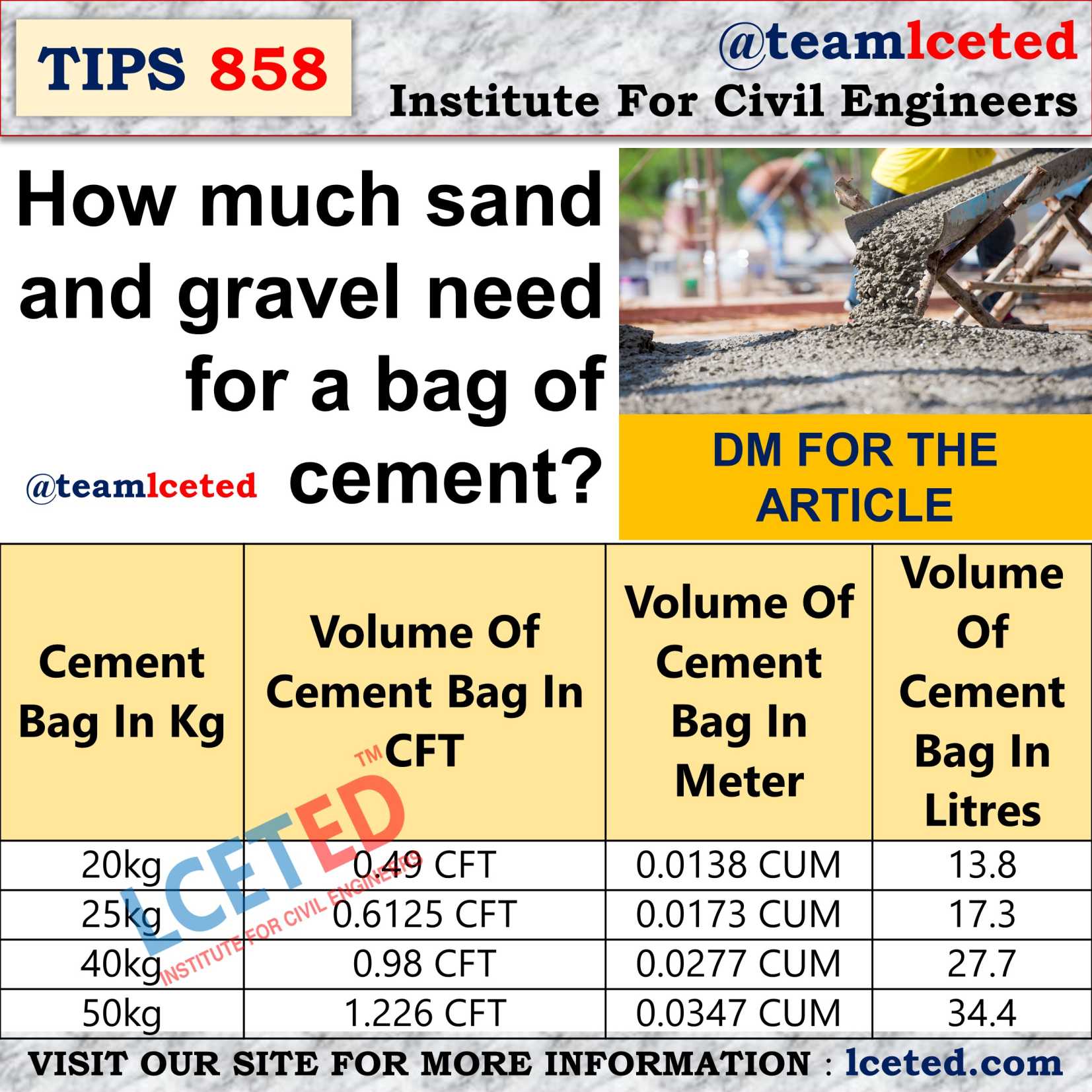In
this article, we explained how to determine the concrete mix ratio in
relation to the number of head pans of sands and gravels that are actually
needed for a bag of cement and How much sand and gravel need for a bag of
cement.
What Is Concrete Mix Ratio?
Concrete
mix ratio is the ratio of concrete materials such as cement, fine aggregate
(sand), coarse aggregate (gravel) and water. This composite ratio is determined
based on the type of construction and the composite designs of the materials.
How much sand and gravel need
for a bag of cement?
Cement bags are generally available worldwide
in different weights, some of which are 20 kg bag, 25 kg bag, 40 kg bag and 50
kg bag.
Therefore
1 Cement Bag In Kg = Volume Of Cement Bag In
CFT
1 Cement Bag In Kg = Volume Of Cement Bag In
Meter
1 Cement Bag In Kg = Volume Of Cement Bag In a litre
|
Cement Bag In Kg |
Volume Of Cement Bag In CFT |
Volume Of Cement Bag In Meter |
Volume Of Cement Bag In Litres |
|
20kg |
0.49
CFT |
0.0138
CUM |
13.8 |
|
25kg |
0.6125
CFT |
0.0173
CUM |
17.3 |
|
40kg |
0.98
CFT |
0.0277
CUM |
27.7 |
|
50kg |
1.226
CFT |
0.0347
CUM |
34.4 |
MUST-READ: How
do we calculate the volume of 50 Kg cement bag?
We
will take M20 ratio of nominal
grade concrete for this calculation
M-20 - 1:1.5:3
M15 grade of concrete then you have to use a concrete mix ratio of 1:1.5:3.
In which 1 is part of cement, 1.5 is part of sand, and 3 is part
of cement.
Therefore, according above table
1 Cement Bag In Kg = Volume Of Cement Bag In
CFT
We will use 50 kg bag,
1 Cement Bag In Kg = 1.226 cft
So,
M-20 – (1=1.226):1.5:3
1.226
cft of cement = (1.226 x 1.5) cft of sand = (1.226 x 3) cft of gravel
M-20 = 1.226: 1.839: 3.678
Therefore 50kg of
cement bag, need 1.839CFT of sand & 3.678 CFT for M20 concrete mix.
Must Read: How
To Convert Cubic Meter To Cubic Feet
How much sand and gravel
of head pan need for a bag of cement?
We will take the Nominal concrete mix ratio
and convert it into a head pan mortar ratio
Nominal Concrete Mix Ratio
|
Grade
of Concrete - Normal Grade Concrete |
Ratio |
Compressive
Strength N/mm2 |
Compressive
Strength (PSI) |
|
M-5 |
1:5:10 |
5 |
725 |
|
M-7.5 |
1:4:8 |
7.5 |
1087 |
|
M-10 |
1:3:6 |
10 |
1450 |
|
M-15 |
1:2:4 |
15 |
2175 |
|
M-20 |
1:1.5:3 |
20 |
2900 |
We
will take M15 ratio of nominal
grade concrete for this calculation
M-15 - 1:2:4
M15 grade of concrete then you have to use a concrete mix ratio of 1:2:4.
In which 1 is part of cement, 2 is part of sand, and 4 is part
of cement.
Therefore, In head mortar head pan ratio
To produce the required
concrete quality 1 mortar head pan cement we need 2 mortar head pan sand and 4 mortar
head pan gravel.
1 pan of cement = 2 pans of sand = 4
pans of gravels
According
to the building contractors association, a 50kg bag of cement can fill up to 2
head pans full of cement. If this is correct, for each bag:
1 bag of cement = 2 pans of cement
1:2:4 = 2:4:8
2 pans of cement = 4 pans of sand = 8
pans gravel
Therefore,
1 bag of cement = 4 pans of sand = 8 pans of gravel
It
means for every 1 bag of cement you will need 4 head pans of sand and 8 head
pans of gravel to obtain concrete strength of grade M15 equal to 12 N/mm2
Examples
M-10 -
1:3:6
1 bag of cement = 2 pans of cement
1:3:6 Mix Ratio = 2:6:12
Pan Ratio
M-20 -
1:1.5:3
1 bag of cement = 2 pans of cement
1:2:4 Mix Ratio = 2:3:6
Pan Ratio
FAQ
How much head pan is there in one bag of cement?
1 bag of cement is equivalent
to two head pans (large size).
1 bag of cement is equivalent
to three head pans (medium size).
What
is the weight of a cement bag?
Cement bags are generally available worldwide
in different weights, some of which are 20 kg bag, 25 kg bag, 40 kg bag and 50
kg bag.
How many Litres is a 50kg bag?
34.4 litre - The volume of
a 50 kg cement bag works out to be (50/1440) x 1000 = 34.4 Litres.
What is the meaning of head pan?
A head pan is commonly used
on construction sites made of iron or plastic. It is used to transport soil or
cement or concrete to the work area.









No comments:
Post a Comment